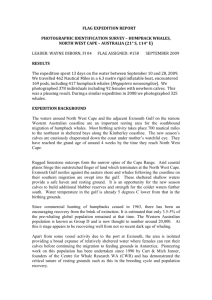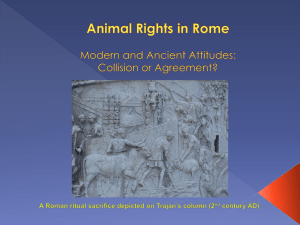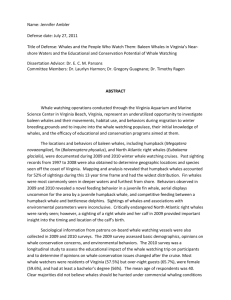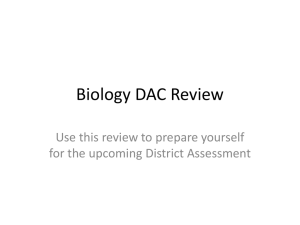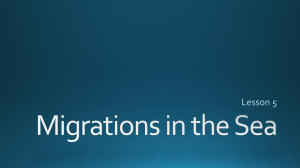DOCX - 26.32 KB - Department of the Environment
advertisement
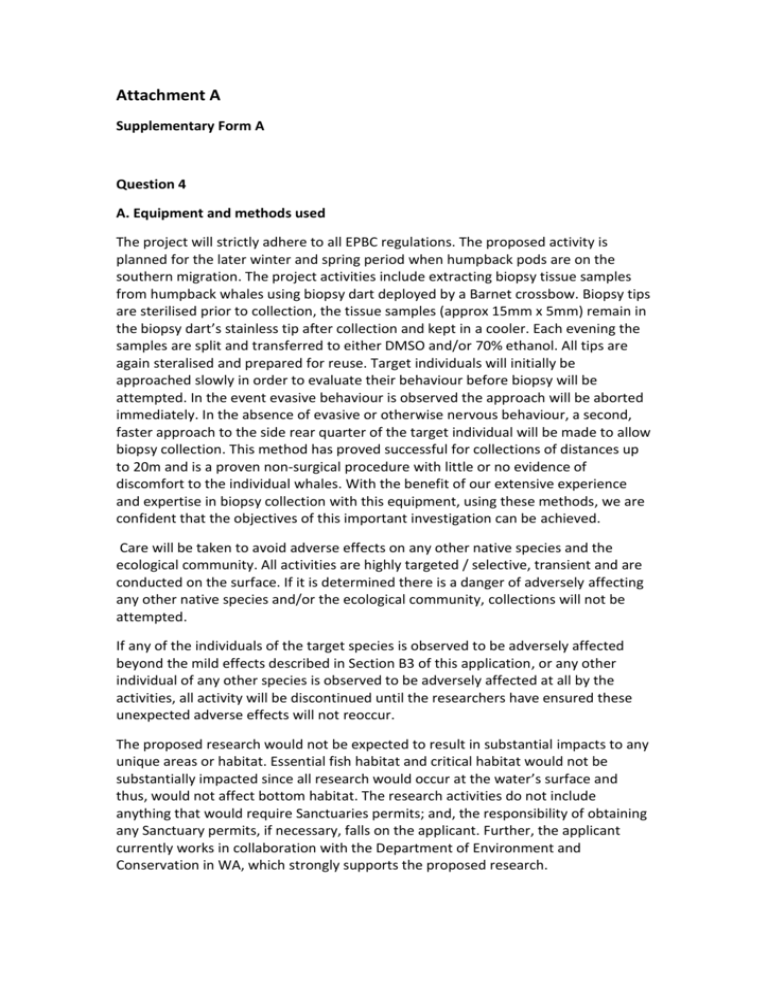
Attachment A Supplementary Form A Question 4 A. Equipment and methods used The project will strictly adhere to all EPBC regulations. The proposed activity is planned for the later winter and spring period when humpback pods are on the southern migration. The project activities include extracting biopsy tissue samples from humpback whales using biopsy dart deployed by a Barnet crossbow. Biopsy tips are sterilised prior to collection, the tissue samples (approx 15mm x 5mm) remain in the biopsy dart’s stainless tip after collection and kept in a cooler. Each evening the samples are split and transferred to either DMSO and/or 70% ethanol. All tips are again steralised and prepared for reuse. Target individuals will initially be approached slowly in order to evaluate their behaviour before biopsy will be attempted. In the event evasive behaviour is observed the approach will be aborted immediately. In the absence of evasive or otherwise nervous behaviour, a second, faster approach to the side rear quarter of the target individual will be made to allow biopsy collection. This method has proved successful for collections of distances up to 20m and is a proven non-surgical procedure with little or no evidence of discomfort to the individual whales. With the benefit of our extensive experience and expertise in biopsy collection with this equipment, using these methods, we are confident that the objectives of this important investigation can be achieved. Care will be taken to avoid adverse effects on any other native species and the ecological community. All activities are highly targeted / selective, transient and are conducted on the surface. If it is determined there is a danger of adversely affecting any other native species and/or the ecological community, collections will not be attempted. If any of the individuals of the target species is observed to be adversely affected beyond the mild effects described in Section B3 of this application, or any other individual of any other species is observed to be adversely affected at all by the activities, all activity will be discontinued until the researchers have ensured these unexpected adverse effects will not reoccur. The proposed research would not be expected to result in substantial impacts to any unique areas or habitat. Essential fish habitat and critical habitat would not be substantially impacted since all research would occur at the water’s surface and thus, would not affect bottom habitat. The research activities do not include anything that would require Sanctuaries permits; and, the responsibility of obtaining any Sanctuary permits, if necessary, falls on the applicant. Further, the applicant currently works in collaboration with the Department of Environment and Conservation in WA, which strongly supports the proposed research. B. What steps will be taken to minimise impacts on cetaceans The actual biopsy will take place quite quickly and vessel will withdraw to minimise any stress on the individual. Emphasis will be put on a slow approach to individuals and avoid long pursuit of n whales that are ‘making way’. The collection of tissue samples can affect a few varied though minimal response from individual whales. This can vary from nil to tail flicks or slaps. Vessel will withdraw when evasive behaviour is observed. Behavioural reactions will be monitored and recorded using the following hierarchical categories… ‘No Response’ when whale show no change in behaviour; ‘Startle’ a sudden but small or subtle movement like a muscle contraction; ‘Fluke Move’ a small non forceful lateral movement of flukes; ‘Immediate Dive and Submerged’ showing obvious avoidance; ‘Fluke Slap’ slapping of surface with tail; ‘Spy Hop’ a controlled slow vertical protrusion; and ‘Breach’ vertical or angled faster leap from the water. To determine which factors may influence the frequency and/or intensity of immediate behavioural responses characteristics of the biopsy shots, vessel used, approach type, whale pod characteristics and the behavioural reactions will be recorded. Additionally the reactions and effects on re-sightings will also be recorded. What can be suggested with a reasonable level of certainty is that the short and long term impacts on the broader population of such a targeted survey are most likely to be negligible. The proposed action is not related to other actions with individually insignificant but cumulatively significant impacts. The short-term stress (separately and cumulatively when added to other stresses the marine mammals face in the environment) resulting from the research activities would be expected to be minimal. However, it is acknowledged that vessel disturbance from commercial and recreational vessels (e.g. whale watching boats) are a concern for this pod of killer whales. While research activities also involve vessel disturbance, diligent monitoring of during these activities have shown that animals rarely react to research vessels. The effects of the proposed action would not likely jeopardize the continued existence of this species and would not likely destroy or adversely modify designated critical habitat. The impacts of the activities are expected to be short-term in nature and result in minimal short-term behavioral responses from close approach and biopsy sampling. No other marine mammals or threatened or endangered species would be affected by the activities. Other research activities associated with the proposed biopsy sampling include photo-ID and passive acoustic recording. This action is not expected to result in any cumulative adverse effects to the species that are the subject of the proposed research or non-target species. The proposed action would not be expected to have more than short-term, negligible impact to individuals and the population. While some whale populations face a number or anthropogenic stressors (e.g., noise, prey reduction, pollution, shipping etc), research vessel interactions between the whales and vessels would be short-term and the researchers are well experienced in conducting research on these animals. Therefore, no cumulative adverse effects that could have a substantial effect on any species, target or non-target, would be expected. C. The objectives and purpose of the action During July – September 2013, and July – September 12014, we conducted the first 2 years on-site research on the group of killer whales sighted each winter along the Ningaloo coast, where they prey on humpback whale calves born during the northward migration. Until quite recently, killer whales in this area have been an unrecognized important predator of humpback whale calves off WA: to date, we have documented predation of at least 14 humpback calves, and we suspect that scores of calves are taken annually by killer whales off WA, and perhaps in excess of 100. Preliminary results from the work undertaken in 2013 and 2014 lend support to these numbers. Observations made over the past eight seasons suggest that humpback mothers draw on two main defence strategies to protect their calves from killer whale attack at Ningaloo: They migrate close along the reef edge, which makes it more difficult for predators to gain access to the calf; and They receive the cooperation of ‘escorts’, i.e. single adult humpbacks that travel with the mother and calf and assist in protecting the calf when killer whales (or large sharks) attack. While the role of escorts in the defence of calves is well documented for a number of whale species in other parts of the world, Ningaloo is the first place where this behaviour has been documented to occur regularly in relation to the protection of humpback calves. In fact, it should be noted that the percentage of escorted mother / calf pairs – which we assumed to be relatively low during the northward migration when single adults may be expected to be more concerned with reaching the mating grounds further to the north – far exceeded our expectations during the 2013 and 2014 surveys. Our current view, formed following completion of the recent surveys, therefore, is that the effect of escort-assisted defence of calves on the success rate of killer whale attack is potentially much more important than initially thought. Hence, much is to be gained from an improved understanding of this behaviour and its effect with respect to the impact of killer whale predation on humpback whale calf survival. The first crucial question we aim to make progress on is: Why do escorts put themselves at risk to protect the calf? Established evolutionary theory suggests that for them to do this, they should be related to either the calf (a sibling or perhaps father), or this behaviour should increase its chance of fathering a future calf by the mother. If escorts were siblings of the calves they protect, then we would expect to find both male and female escorts, but to date, biopsy samples from escorts in Hawaii and other populations, have shown them to be mainly males. If this holds true for WA, and our preliminary results suggest that this may indeed be the case with 16 out of 16 escorts sampled in 2013 being male, then mating is probably the main driver of escort behaviour. Then, of course, the question becomes: Is the escort the father of the current calf or, more likely, is his escort behaviour aimed at increasing the chance of future mating? To help understand how escorts benefit from assisting females in protecting their calves, we propose to collect biopsy samples from all whales in these trios (i.e. the mother, the calf and the escort) in order to test the relatedness of the escort to the mother/calf pair. Apart from resolving some of the questions surrounding the social structure of humpback whale pods, the results of this research may also be expected to give us an important insight into the implications of escort behaviour on the success rate of KW attack and, hence, the survival rate of humpback calves more generally. Detailed description of proposed action: The proposed action involves the collection of tissue samples of all individuals in cow, calf and escort humpback whale trios. While we propose to sample during both the northward and southward humpback whale migration, we expect to collect the majority during the southward migration in September and October. The activity will be spread over 3-4 seasons along the Western Australian coast, using the same protocol for which we are already currently permitted. The aim is to collect up to 40 full sets (i.e. mother, escort and calf) in order to undertake a genetic analysis into the relatedness of the escort to the mother/calf pair. This data is required to resolve several key questions surrounding the ‘motive’ of humpback whale escorts, which – as indicated by the results from the 2013 and 2014 surveys – has the potential to affect the success rate of killer whale attacks on humpback calves and, hence, the impact of killer whale predation on humpback calf survival. Please see the Section 3 for further details. As our approved protocol already includes biopsy sampling of humpback mothers and escorts, the additional sampling of the calves in these trios will not significantly alter sampling operations. Justification for the number of additional animals requested: We expect to need approximately 40 sets of tissue samples from mother, calf and escort trios in order to complete a robust scientific genetic analysis. This brings the number of biopsy samples needed for this study to 120, including the 40 calves. In order to achieve this goal (given that the sampling will not involve undue ‘pursuit’ or stress to the calves) we expect that we will need to approach around 60 trios over several seasons, i.e. expecting at least a 2/3 success rate. For pods where we sample only 1 or both adults but do not sample the calf, the number collected will not be able to count towards the particular study that is the subject of this permit. Given that some years may prove better for collections than others, we would, ideally, be able to biopsy 20 trios in a single year, without changing the total. To accommodate this - taking into account the 30 adults per year allowed under the current permit (i.e. total 150) and using our 2/3 success estimate - the total number of tissue samples required under the new permit is 80, i.e. 40 calves and 40 adults. Consequently the total number of tissue samples required under both permits is 230. We expect this is will give us the room to collect sufficient complete sets to undertake a robust analysis. Year 2013 - 14 2014 - 15 2015 -16 2016 – 17 2017 - 18 TOTAL Existing Permit Whales > 1 year 30 (23 realised) 30 30 30 30 150 Adults New permit Calves < 1 year 10 10 10 10 40 20 max 20 max 20 max 20 max 40 Table 1. Showing numbers of humpback biopsy collections 2013 - 2018 Question 5. Principal researchers and institutions involved in the proposed research: John Totterdell – Marine Information and Research Group (Australia) Hans Kemps – Marine Information and Research Group (Australia) Dr Robert Pitman – Protected Resources Division Southwest Fisheries Science Center NOAA Relationship between researchers and applicants – colleagues. Referee for J. Totterdell and H Kemps Arvid Hogstrom – District Manager, Department of Environment and Conservation (DEC WA) Arvid.Hogstrom@dec.wa.gov.au Referee for R. Pitman Nick Gales – Chief Scientist, Australian Antarctic Division nick.gales@aad.gov.au
